What’s a BOB you ask? It’s a Bug-Out Bag, containing almost all the essentials if you need to leave your house. It’s a term popularised by the survivalist crowd, but it can also be an important tool for people living with Type 1 Diabetes. Consider a couple of possible scenarios:
 You’re involved in an accident and end up in hospital. You need someone (partner/friend/family) to bring your essentials (such as insulin pump consumables). Can you tell them all the bits and pieces they need to gather and bring? Or can you just tell them to go to the wardrobe and pick up your BOB to bring in?
You’re involved in an accident and end up in hospital. You need someone (partner/friend/family) to bring your essentials (such as insulin pump consumables). Can you tell them all the bits and pieces they need to gather and bring? Or can you just tell them to go to the wardrobe and pick up your BOB to bring in?
 Or maybe there’s a natural disaster and you need to evacuate. This is an all-too-real scenario for many Australians at the moment, with fire storms ravaging the country (along with the other “usual” things like floods and cyclones).
Or maybe there’s a natural disaster and you need to evacuate. This is an all-too-real scenario for many Australians at the moment, with fire storms ravaging the country (along with the other “usual” things like floods and cyclones).
So, how much gear do you need? Traditionally a survivalist’s BOB would have 3 days’ supplies. But for coping with evacuations and natural disasters with diabetes, I think we should have more than that.
A decent rule-of-thumb would be to have enough supplies for 14 days. Sure you hopefully only need one or two, but what if you don’t have a home to come back to?
What I have in my own diabetes BOB
A lot of stuff, basically. I’ll list the overview, then describe the whys and hows.
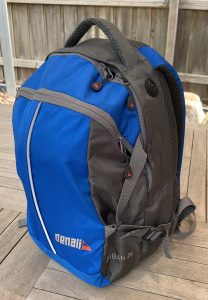 I don’t maintain a general “survivalist” BOB, but I do have one with all the medical supplies. If we were evacuating the house there’d be a few other things we’d be grabbing (including clothes, the encrypted backup drives that contain our digital lives, as well as essentials such as pets and other family members!). But this article is just about a “diabetes BOB”.
I don’t maintain a general “survivalist” BOB, but I do have one with all the medical supplies. If we were evacuating the house there’d be a few other things we’d be grabbing (including clothes, the encrypted backup drives that contain our digital lives, as well as essentials such as pets and other family members!). But this article is just about a “diabetes BOB”.
Keep in mind that these things usually stay in this bag all the time. Where possible they’re spares: not things I have out and about being used (and possibly misplaced by the time an emergency happens).
- Some clothes.
- Printed list of my insulin doses and medications.
- Essential medications.
- Emergency food.
- BG meter, strips, lancing device and lancets.
- Pump reservoirs.
- Infusion sets (and inserter if required).
- Alcohol swabs.
- Insulin pens, with needles.
- Sharps container.
- Frío cooling wallet.
- Spare batteries.
- USB battery, with cables to charge my phone/etc plus a wall-charger to recharge the battery.
- Backup phone (with loop and CGM software installed).
- CGM sensor.
That’s a lot of separate pieces, and I don’t have them all just swimming in the bottom of the bag. I have some old plastic lunch boxes (clear Sistema ones) keeping things organised in there.
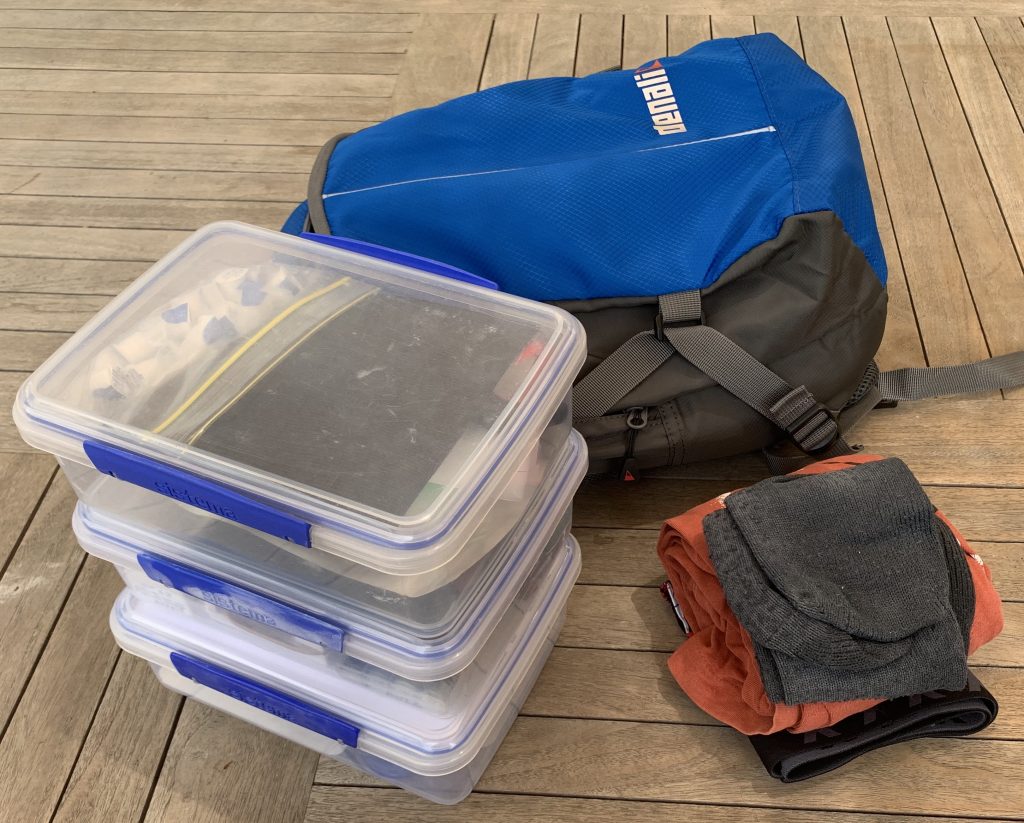
Breaking it down
The list above is just the summary. It’s worth explaining some details, so I’ll list them below.
Some of the things in the bag will expire, so I have a calendar appointment reminder set to check things every 3 months (e.g. to cycle in fresh BG strips if necessary, to recharge batteries, etc).
Medication list
Mainly useful when going into hospital, it doesn’t hurt to have these documented on paper.
As I’ve described previously I already have scanned copies of my current prescriptions stored on my phone.
Insulin
I do not keep insulin in the bag. It lives in the fridge at about 6˚C.
Grabbing the bag to go does require one extra step: grabbing a box of insulin from the fridge and putting it into the bag. The insulin I use is packaged in 3ml pen cartridges.
Other medications
I have a regular daily schedule of medications I take (the list has gradually been growing as I get older). The prescription ones come in blister packs, and the PBS prescription schedule allows me to gradually build up some spares. I have been able to set aside 14 days worth of the essential meds for the BOB. These aren’t quite as temperature-sensitive as insulin, and have quite long expiry dates.
Emergency food
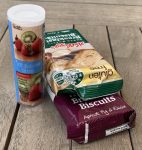
I might need hypo treats, and I might need some longer-acting carbs. Unfortunately with my coeliac disease I can’t eat gluten, so it’s safest for me to have at least one or two in the BOB. It’s not enough for 14 days, but in a planned evacuation I’d of course be grabbing more supplies from the pantry.
Clothes
This isn’t really to cope with evacuation conditions. I do figure that in that scenario I’d be throwing more clothes into another bag. But for hospital stays I do at least have an old T-shirt as well as underpants and socks in here.
BG meter, etc
My CGM might fail, but I’ll need to calibrate it occasionally anyway. So having a meter is important.
Here in Australia we get BG strips subsidised through NDSS and not through specific prescriptions, so it’s feasible to have several different meter types. Earlier last year my BOB contained the Accu-Chek Performa Combo meter that came with my insulin pump (not the meter I usually use). Partly because it takes AAA batteries which should be fairly accessible in emergencies (whereas my usual meters use CR2032 button cells). And partly because I had it anyway.
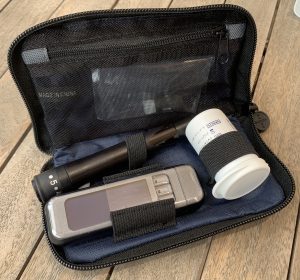 But today my bag has an old Contour Next meter that is USB-charged. It’s smaller than the Performa Combo, and it shares the same BG strips as some of my other meters (letting me cycle new strip containers through the BOB without wasting any).
But today my bag has an old Contour Next meter that is USB-charged. It’s smaller than the Performa Combo, and it shares the same BG strips as some of my other meters (letting me cycle new strip containers through the BOB without wasting any).
Pump reservoirs
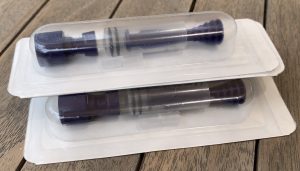 With my pump and my insulin needs, enough reservoirs to last me 14 days (plus a spare) means 3-4 reservoirs.
With my pump and my insulin needs, enough reservoirs to last me 14 days (plus a spare) means 3-4 reservoirs.
Infusion sets
At 3 days per cannula (plus a spare) 14 days comes to 6 sets.
I use a variety of different sets so I’m quite flexible. Especially when travelling I tend to use TenderLink/VariSoft/Silhouette-type sets as they take up hardly any space. But these require manual insertion and can be quite daunting for someone not familiar with the process. Consider if I was hospitalised and unable to do it myself…
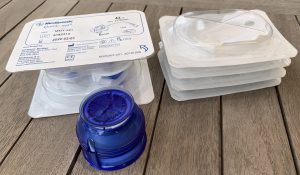 So as a compromise my BOB currently contains four TenderLinks, plus two Medtronic Quick-Sets with a Quick-Serter. Talking someone through inserting a Quick-Set might be easier than with TenderLink.
So as a compromise my BOB currently contains four TenderLinks, plus two Medtronic Quick-Sets with a Quick-Serter. Talking someone through inserting a Quick-Set might be easier than with TenderLink.
Alcohol swabs
I have a handful of swabs in there. Actually a mixture of plain isopropyl swabs and isopropyl/chlorhexadine swabs (partly because I had those in a drawer anyway).
Insulin pens
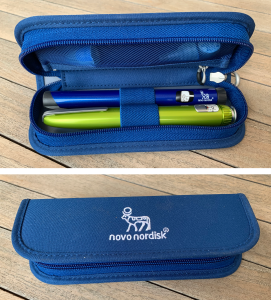 These are a backup to the pump: not my usual tools. These are not disposable pens: these are empty ones that take 3ml refill cartridges. I have both a HumaPen and a NovoPen, just to be flexible in emergencies. And a basic supply of needles in a ziplock bag.
These are a backup to the pump: not my usual tools. These are not disposable pens: these are empty ones that take 3ml refill cartridges. I have both a HumaPen and a NovoPen, just to be flexible in emergencies. And a basic supply of needles in a ziplock bag.
I used to use Humalog, I currently use Fiasp, and if I had to fall back to MDI I would probably use Levemir as my basal. So having two pen styles is safest. I’ve covered in the past how a HumaPen can be used with Sanofi insulins such as Apidra and Lantus (both of which I have used in the past and could do so again in an emergency).
Sharps container
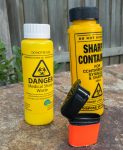 I have a small sharps container in here. If I’m in emergency accommodation, the last thing I want to have to deal with is where to safely put sharps without risking myself or others. I’ve previously written about Managing sharps safely.
I have a small sharps container in here. If I’m in emergency accommodation, the last thing I want to have to deal with is where to safely put sharps without risking myself or others. I’ve previously written about Managing sharps safely.
Frío wallet
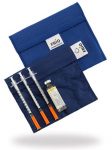 All the Frío needs to give me enough cooling to keep insulin at a safe temperature for long periodsis to be temporarily soaked in water. I have two I use for travel (where my insulin is split into two stashes) and when I’m at home one of them lives in my BOB. It’s kept dry so it’s smaller and doesn’t give off humidity, but available if I need it.
All the Frío needs to give me enough cooling to keep insulin at a safe temperature for long periodsis to be temporarily soaked in water. I have two I use for travel (where my insulin is split into two stashes) and when I’m at home one of them lives in my BOB. It’s kept dry so it’s smaller and doesn’t give off humidity, but available if I need it.
Spare batteries
Just a few alkaline AA and AAA batteries for use in pump, meter, etc can get you out of a jam.
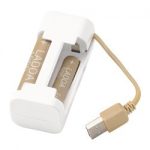 I also have some NiMH rechargeable batteries. The low-self-discharge versions (e.g. Eneloop or LADDA models) which won’t be flat when you need them. With them is a tiny VINNINGE AA/AAA charger from IKEA. This can charge 1 or 2 NiMH batteries at a time from USB, and has been an excellent tool in my photography travel kit for years.
I also have some NiMH rechargeable batteries. The low-self-discharge versions (e.g. Eneloop or LADDA models) which won’t be flat when you need them. With them is a tiny VINNINGE AA/AAA charger from IKEA. This can charge 1 or 2 NiMH batteries at a time from USB, and has been an excellent tool in my photography travel kit for years.
USB battery
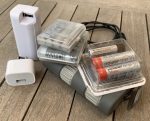 Actually I have two powerpacks in here. One is a 10,000 mAh battery with two USB ports.
Actually I have two powerpacks in here. One is a 10,000 mAh battery with two USB ports.
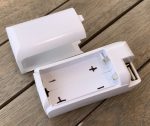 The other is a little gadget I picked up in Japan a few years ago (similar things can be found on eBay). It takes a 2 or 4 AA batteries and can then charge USB devices: perfect for having options in a disaster scenario.
The other is a little gadget I picked up in Japan a few years ago (similar things can be found on eBay). It takes a 2 or 4 AA batteries and can then charge USB devices: perfect for having options in a disaster scenario.
In fact there are similar devices available today which at the flick of a switch go from powerbank to AA/AAA charger. But I’m using the gadgets I already had.
My iPhone needs a Lightning charge cable, my AndroidAPS phone needs USB-C, the USB battery itself needs micro-USB, and my watch has its own charge cable. So I have a few cables in there. A tiny Apple USB wall charger completes the power setup.
CGM sensor
My Dexcom G5 sensors have been lasting an average of 25 days each. So I only keep one spare in the BOB.
I also have several sheets of Fixomull Transparent tape (cut to size from a roll and with the corners rounded) which I use to cover my sensors. The batteries in my transmitters last several months between charges so I don’t bother keeping a charger in the bag.
Backup looping phone
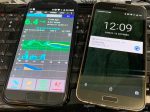 The AndroidAPS phone that runs my loop is an essential piece of my equipment, and just like I have backups for everything else, I have a backup for it. It’s a fairly basic (read: “cheap”) phone but is already configured with all the right software installed. No SIM in it, but there is a pin with it to allow me to swam SIMs between phones if needed.
The AndroidAPS phone that runs my loop is an essential piece of my equipment, and just like I have backups for everything else, I have a backup for it. It’s a fairly basic (read: “cheap”) phone but is already configured with all the right software installed. No SIM in it, but there is a pin with it to allow me to swam SIMs between phones if needed.
I have swapped my loop between phones a number of times, so it won’t take me long to get running if something happened to my primary loop phone.
Refreshing the BOB
All of this fits within a small (25L) cheap backpack that lives in the bottom of my wardrobe. At least every 3 months I get it out and refresh everything:
- Recharge batteries, meter, and phone.
- Turn phone on and apply all relevant software updates.
- Update the list of current medications.
I also replace various items with newer ones (later expiry dates) and put the ones taken out of the BOB back into my “pool” as the next ones to be used:
- CGM sensor
- Pump reservoirs and infusion sets
- BG test strips
- Food packets
- Medications
The BOB goes back into the wardrobe, and I (and my family) know what to grab in an emergency.
What do YOU need?
You might not want to bother with a BOB as comprehensive as mine, but even a little bit of preparation will go a long way to ensuring your safety in an emergency.
I do hope none of us need to use our BOBs!

Thank you David for showing what your BOB contains. That is a great prompt to us all. I have included some other things as well as a few comfort things as fatigue makes us more likely to make mistakes and we can less afford mistakes.
For me, on a Tandem pump, the USB battery banks need to be able to charge the internal rechargeable Tandem battery as well as phones, so appropriate mini-USB to connect to the pump is needed as i have an iPhone with lightning cable,.
I would include a small torch because it is very frustrating trying to change pump reservoirs and pump infusions sets and draw up insulin andgive injections in the dark. My mobile phone could help but if trying to save its phone power for emergencies then the torch is useful.
Insulation material for insulin is a given heat is the enemy to us too. Long sleeve cotton shirts/ blouses and pants etc seem safer than synthetic materials and a coat/vest of some sort as i like to carry at least some of my diabetic supplies on myself. Who knows if your luggage might get misplaced. Good shoes seem sensible, afterall we are told to look after our feet. And a hat, for shelter, to handle something hot and ,heaven forbid, hold water. I pack some of my emergency kit in a drink container so it can double as a cup. A whistle is a tiny item which can be useful, as well as a can opener, otherwise why pack tinned food. Wearing one’s alert bracelet/necklace seems sensible.
One important item that people lost for days reported on after they were found was lack of a pillow to rest their head on, so an inflatable travel pillow does not take up much space and better resting means less fatigue.
Long ago before disposable syringes etc, on canoe trips in wilderness, i took some matches, an old aluminium can, a wire cradle for inside the can, glass syringes and separate metal needles, tweezers, some distilled water and a plastic container with metho. Now that is ‘real’ survival stuff! But if your disposable pump items, pen etc goes up in smoke? Just an outfield thought.
Finally, packing a kit glucagon might be worth consideration, provided someone is trained in its use. I recall a hiking trip some 40 years ago where, out in the Blue Mountains, a fellow diabetic went unconscious one evening with a hypo. Glucagon saved him from harm or death.
I am sure others will have other items to consider and look forward to reading about them. Thank you again, Davd.
Everyone will want to customise their own BOB for their own needs. Some will want more stuff, some will want less.
Shoes, tinned food, etc start turning it into a full-blown survival kit. You could throw in solar panels as well I suppose. But I have aimed for something that just covers all my diabetes needs comfortably.
Incidentally, your Tandem pump uses a micro-USB connection, not a mini-USB (different physical connector). Don’t get caught out by looking for the wrong thing.